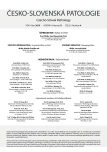Diagnosis of rejection in a transplanted liver
Authors:
Eva Sticová; Eva Honsová
Authors‘ workplace:
Pracoviště klinické a transplantační patologie, Transplantcentrum IKEM, Praha
Published in:
Čes.-slov. Patol., 51, 2015, No. 4, p. 166-168
Category:
Reviews Article
Overview
Despite advances in immunosupressive therapy rejection remains the most common complication of liver transplantation in both the early and the late post-transplant period. Unlike other solid organs, liver graft rejection has some specific characteristics likely attributable to the unique immunobiologic properties and the remarkable regenerative capabilities of liver parenchyma. Acute cellular rejection is the most frequent type of the rejection episode in the liver allograft, whereas chronic (ductopenic) rejection and humoral rejection are uncommon. Since the clinical findings are not entirely characteristic, histopathological evaluation of liver biopsy remains the gold standard in the diagnosis of rejection. However, the close cooperation between the pathologist and the clinician is essential for the correct interpretation of morphologic changes.
Keywords:
cellular rejection – liver biopsy – immunosupressive therapy – transplantation
Sources
1. Banff Working Group on Liver Allograft Pathology. Banff schema for grading liver allograft rejection: an international consensus document. Hepatology 1997; 25(3): 658-663.
2. Demetris A, Adams D, Bellamy C, et al. Update of the International Banff Schema for Liver Allograft Rejection: working recommendations for the histopathologic staging and reporting of chronic rejection. An International Panel. Hepatology 2000; 31(3): 792-799.
3. Demetris AJ, Adeyi O, Bellamy CO, et al. Liver biopsy interpretation for causes of late liver allograft dysfunction. Hepatology 2006; 44(2): 489-501.
4. Neil DA, Hübscher SG. Current views on rejection pathology in liver transplantation. Transpl Int 2010; 23(10): 971-983.
5. Hübscher SG. Central perivenulitis: a common and potentially important finding in late posttransplant liver biopsies. Liver Transpl 2008; 14(5): 596-600.
Labels
Anatomical pathology Forensic medical examiner ToxicologyArticle was published in
Czecho-Slovak Pathology

2015 Issue 4
Most read in this issue
- Periosteal osteosarcoma - personal experience with five cases
- Transplantations of lungs in the Czech Republic – from the perspective of the pathologist
- Diagnosis of rejection in a transplanted liver
- Surgical techniques of organ transplants
